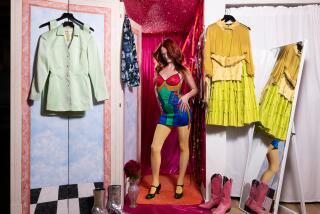Nicola Trussardi; Head of Italian Fashion Accessories Firm Dies in Traffic Accident
- Share via
Nicola Trussardi, whose luxury fashion accessories made the firm that bears his name one of Italy’s most popular designers, has died.
Trussardi died Wednesday of injuries he sustained in a car accident Tuesday night on the outskirts of Milan. He was 56.
News reports from Italy said police were investigating the crash. Police reportedly believe that Trussardi may have suffered a stroke or other debilitating health problem and lost control of his car.
Trussardi’s family approved the donation of his organs after he was declared dead. His transplanted liver immediately saved the life of a 54-year-old man in critical condition with cirrhosis, doctors said.
Although he never attained the fame of such colleagues as Georgio Armani and Gianni Versace, Trussardi’s sporty, well-tailored lines contributed to the popularity of the made-in-Italy label throughout the world.
The House of Trussardi was historically a purveyor of leather goods and came to prominence making gloves for the Italian Army in the years before World War II. And gloves continued to be the firm’s mainstay until the late 1960s, when the public abandoned the “civilized and long-standing habit of wearing gloves,” according to a company history.
The model-handsome Trussardi, grandson of the firm’s founder Dante Trussardi, took over the family business in the early 1970s following the death of his older brother in an auto accident. Trussardi, as the second son, knew little about the fashion world and had planned an independent career as a management consultant.
But in taking over the firm, he decided to reshape it by focusing on the diversification of the product line. He established a tannery and developed new and innovative procedures for the actual processing and finishing of leather. He launched a new series of products ranging from wallets, shoes and suitcases to baggage, belts and bags. To represent his rapidly growing firm, Trussardi selected the greyhound as a distinctive logo.
He was not an artist or a designer--his wife Maria Luisa Gavezzani was the vital force in the creative end--but he was said to be wise at gauging the changing public tastes in clothing and did much to put leather clothing on the backs of fashionable men and women.
“Trussardi’s field is not haute couture, and Trussardi is not a couturier,” Italian sociologist Francesco Alberoni once told the International Herald Tribune. . . . [He is] “an entrepreneur of taste.”
Trussardi knew that the up-scale market had more money to spend on accessories than the motorcycle crowd previously identified with leather. And Trussardi was ready to supply those accessories in the way of belts, bags, and shoes.
The business took off in the early ‘80s after Trussardi launched his first women’s collection with great fanfare with a show at the legendary La Scala Opera House in Milan. He followed that the next year with a collection of fashions for men. In 1986 he designed the costumes for Jose Carreras on stage at the Verona Arena and for Verdi”s “Macbeth.”
Trussardi marketed his lines wisely and stuck to areas of the world he believed would be most successful. By 1995, Trussardi’s products and licenses generated sales of around $500 million annually, with just over half of that business coming from Asia, particularly Japan.
He stayed away from the competitive North American market although some of his lines were available at specialty stores like Saks Fifth Avenue and Nieman Marcus. But in the last three years the Trussardi company had been broadening its presence in the United States. The company opened a showroom and headquarters on Fifth Avenue in Manhattan and had been scouting New York for a location for a free-standing flagship store.
In the last few years, the company has branched out into the area of commercial industrial design working with some of Italy’s largest companies in the creation of aesthetic environments.
In a newspaper interview some years ago, he credited his grandfather with instilling in him a sense of quality in design and workmanship.
“I’ve studied, I’ve traveled the world, but the most important things I’ve learned in Italy making the round of workshops with my grandfather Dante,” he said. “When it comes to leather, he was a real artist--he could sniff out the best immediately.”
He is survived by his wife and four children.
Funeral services are scheduled for Saturday in Milan.
Times Senior Fashion Writer Valli Herman-Cohen contributed to this story.






